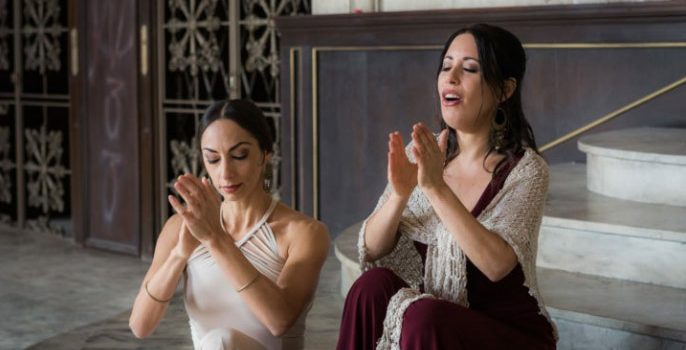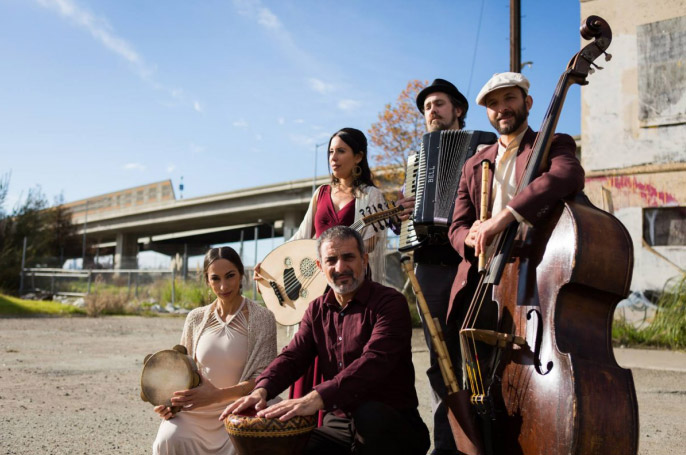Rachel and Miriam’s Sephardic Jewish odyssey
Miriam Peretz and Rachel Valfer grew up together in Berkeley, shared an apartment as students in Jerusalem, and have reunited in the East Bay, drawn by an enduring friendship and passion for the culture of Sephardic Jewry.
They premiere their new collaboration Madre: The Ladino Project 7 p.m. Sunday at Freight & Salvage, a vivid reimagining of the music and dance that spread across the Mediterranean following the expulsion of Jews from Spain in 1492.
Featuring Peretz’s choreography and Valfer’s sumptuous vocals and deft guitar work, the Ladino Project brings together some of the region’s most illustrious musicians exploring Arabic, Balkan and Near Eastern music, including Eliyahu Sills on bass and ney (Turkish end-blown reed flute), Dan Cantrell on accordion and other instruments, and Faisal Zedan and Tobias Roberson on Middle Eastern percussion.
Comprised of Old Spanish with vocabulary drawn from Turkish, Hebrew, Aramaic, and Arabic, Ladino is a language that has survived multiple diasporas, with a rich tradition of songs. As the project’s name suggests, “Madre” focuses on music associated with women, rather than masculine ballads known as romansas. 1/3 “I’ve always loved the music and poetic heritage of Ladino tradition,” says Valfer, who graduated from Berkeley High in 1992. “Even in high school I was singing this stuff. What’s really interesting to me are the cantigas, the oral song tradition about the experience of womanhood, mothers singing to a baby, a maiden concerned about finding the right partner. They’re kitchen and cooking songs, and songs about growing old and dying.”
While Valfer has a well-documented body of music to explore, Peretz faces a very different creative challenge. As a particularly fragile and hard to document art form, dance didn’t survive the Spanish expulsion, and whatever traditions evolved in the dispersal have dissipated in the diaspora.
“There is no Ladino dance tradition,” says Peretz, Berkeley High class of ‘94. “In Jewish music culture there’s just not much of a dance tradition. It was lost. They adapted into whatever culture they were living. So not so much reconstructing a tradition as constructing one, based on the many cultures that Ladino pulls together. Spanish, Turkish and also my own creative voice and contemporary movements.”
Peretz is uniquely prepared for this creative journey, by both birth and experience. Her father hails from a Moroccan Sephardic family, and her mother’s Polish family traces their origins back to Spain. Her parents met in Israel, where she was born, but after they divorced her mother Estelle Frankel moved to Berkeley to open a practice as a psychotherapist (and to teach Jewish mysticism).
Upon graduating Berkeley High, where she studied dance, Peretz moved back to Israel and spent years traveling around the Middle East, Spain, North Africa and Turkey “on search to find a voice in dance that felt like my own, where I could express myself,” she says. Dividing her time between Berkeley and Israel, she’s been a principal dancer with Tel Aviv’s Inbal Ethnic Dance Theater and served as principal dancer, choreographer, lead instructor and assistant artistic director of the Bay Area’s Ballet Afsaneh (among other Bay Area companies).
She distills a lot of her far-flung knowledge at Berkeley’s Mahea Uchiyama Center for International Dance on Feb.
17-20, when Nava Dance Art Sanctuary presents “Sacred Dance of the Silk Road,” an intensive introduction to Peretz’s technique, choreography, improvisation and group ritual.
Valfer came to singing much later than Peretz found herself through dance. She studied oud for a while in Israel, but focused more on Ladino, immersing herself in the language for several years taking graduate courses at the Hebrew University of Jerusalem. Singing songs in Ladino led to music in Arabic and Azeri, “and the more I did it the more good feedback I got,” she says. “Singing fully came to the forefront as I learned how to produce sound in a certain way.”
Peretz and Valfer’s paths continued to cross, and as “she was diving in deep studying music, I was falling in love with Middle Eastern culture and studying flamenco,” Peretz says. “We have a long history. We played music together, and created folkloric suites together in Jerusalem. It’s very meaningful to be working together 20 years later. We’ve continued on that path, perfecting and going deeper.”
Back in Berkeley, she started to look for musicians to collaborate with, a quest that brought her to Za’atar, a group devoted to the music of Mizrahi peoples (Jews who hail from Arab countries). It’s where she met Eliyahu Sills, who became her husband and co-founder of the Qadim Ensemble, a fascinating group with Faisal Zedan on Arabic percussion and Geri Hegedus on saz, Persian setar, and oud.
Sunday’s concert is the first installment of a work in progress. Both women envision The Ladino Project as a multimedia production, including projections and a larger cast of performers, including flamenco artists. There also developing themes to connect the songs, drawing on the skills of Dan Cantrell, a prolific and highly respected composer for film and television.
“We’re recreating these songs in a contemporary way, not just as relics of the past,” Valfer says. “As far as research, there’s no way of knowing what the original sound was like. We can try to be true to the harmonic schemes that would have been natural, but we don’t want to bind ourselves to being authentic. We want to take it and make it music that means something to ourselves. It’s a balancing act, and that’s part of the fun.”


